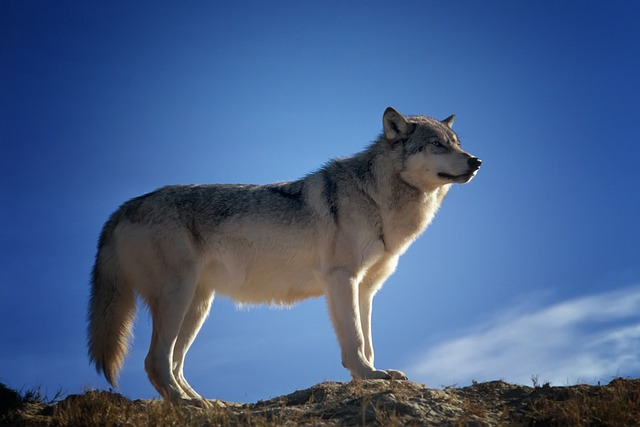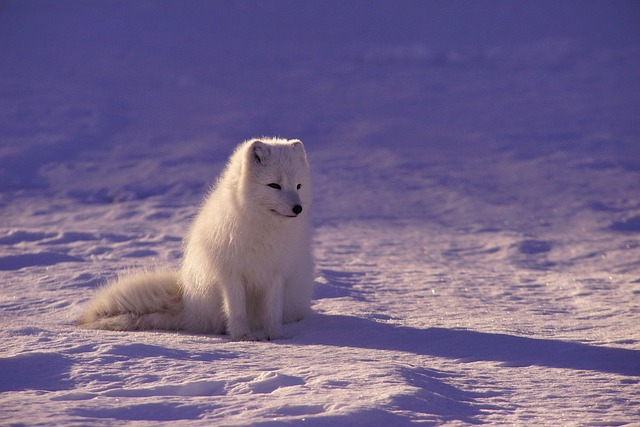The gray wolf, also known as the timber wolf, is the largest and most widely distributed wolf species. It is native to Eurasia and North America and can be found in various habitats such as forests, tundra, and mountains.

Gray wolves are typically larger than their cousin, the coyote, with males growing up to 145 pounds in weight and females averaging between 70 to 100 pounds. Their muscular bodies and large paws help them move swiftly across any terrain.
Moreover, there are many other subspecies of gray wolf that are large compared to the gray wolf. We will explore the largest wolf species in this blog.
What is the biggest wolf species in the world?
The Biggest Wolf: Gray Wolves
The Gray Wolf, also known as the Timber Wolf or the Western Wolf, is one of the wild wolves found in North America.
Reaching up to six feet in length and weighing as much as 175 pounds, these powerful predators have been known to take down large prey such as moose and elk.
They are also highly intelligent with a complex social structure, making them one of the most successful animals in the wild. Gray Wolves have been around for thousands of years and can be found all across North America.
Additionally, the largest subspecies of the gray wolf is Northwestern Wolf (Canis lupus occidentalis). It weighs around 72 kg and can grow around 7 feet long.
With this, the physical growth of the wolves follows Bergmann’s rule, which says that the higher and colder regions they live in, the bigger they grow.
This rule further says that the lower and warmer region a wolf lives in, the shorter the wolf will be.
Steppe Wolf
Steppe Wolf, also known as the (Canis lupus campestris) is the largest wild wolf of the canine family. It weighs between 40 to 175 pounds and measuring from 33 inches tall.
They have greyish coats with a tan tinge and brown or white on their underbelly and legs. Their ears are large and pointed, while their eyes range from amber to pale yellow.
They are also known to be more aggressive than other gray wolves and have longer legs, which gives them the agility to leap great distances while hunting prey.
Their diet consists mainly of small animals like deer and wild boar, but they can also feed on carrion.
Northwestern Wolf (Canis Lupus Occidentalis)
The Northwestern Wolf, also known as Mackenzie Valley wolf, Alaskan timber wolf, or Canadian timber wolf, is a medium-sized canine species native to western North America.
They typically weigh between 55 and 115 pounds and measure around 7 feet in length. They have a thick grayish-white coat that helps them blend in with their surroundings and a bushy tail that aids in balance when running.
These wolves have strong jaws, sharp canine teeth, and powerful legs that help them run up to 35 miles per hour for short distances.
Arctic Wolf (Canis Lupus Arctos)
The Arctic Wolf, also known as the White Wolf or Polar Wolf, is a subspecies of gray wolf native to Canada’s far northern arctic regions. These arctic wolves are well adapted to their harsh environment.

Their thick white fur keeps them warm in temperatures below minus degrees.
The Arctic Wolf’s size and weight vary depending on where it lives, but typically they weigh between 50-175lbs and have a body length of 36-72 in (91-183 cm).
Alaskan Interior Wolf (Canis Lupus Pambasileus)
The Alaskan Interior Wolf, or Canis Lupus Pambasileus, is a subspecies of the gray wolf. These wolves are commonly found in the interior regions of Alaska, British Columbia, and parts of the Yukon and Northwest Territories.
These wolves usually weigh between 115-145 lbs and have an average length of 33.5 inches tall, making them one of the largest species of wolves in the world.
They can run up to 45 mph and live for up to 10 years in the wild. These wolves are highly social animals, living in packs of 7 to 9 wolves.
Northern Rocky Mountain Wolf (Canis Lupus Irremotus)
The Northern Rocky Mountain Wolf is a subspecies of the Gray Wolf and is native to the northern regions of Idaho, Montana, Oregon, and Washington.
It’s an apex predator with a formidable size and weight. Adults typically measure 26 to 32 inches and weigh between 70-150 pounds. These wolves prefer living in forests and can be found in mountainous regions.
What Is The Largest Wolf Species In Eurasia?
Eurasian Wolf (Canis Lupus Lupus)
The Eurasian wolf (Canis Lupus lupus) is a species of gray wolf native to Europe and Asia. It is the largest carnivore in its range and the ancestor of all modern wolves.
They are highly adaptable and can be found in various habitats, including forests, grasslands, deserts, tundra, mountainous terrain, and urban areas.
The adult Eurasian wolf’s height ranges from 26-35 inches, with males typically reaching larger sizes than females.
The average weight for an adult Eurasian wolf ranges from 55-110 pounds, with males typically being heavier and reaching wider sizes.
The Eurasian wolf is a highly social animal that uses different vocals to communicate with its pack members through barking, howling, and body language.
Tundra Wolf (Canis Lupus Albus)
The Tundra Wolf is a subspecies of the Gray wolf, which can be found roaming the northernmost regions of North America, Europe, and Asia.
They are known for their large size and weight, as an average adult male can weigh between 108 pounds. Females tend to be significantly smaller, with an average weight of around 90 pounds.
They hunt in packs, and their diet includes caribou, muskoxen, and Alaskan hares.
Dire Wolf: Did It Really Exist?
According to some paleontologists, the dire wolf is an extinct wolf species that coexisted with humans around 10,000 years ago. The dire wolf was larger and heavier than the gray wolf, the modern generation of it.
Conclusion
The grey wolves are the largest wolves, having many subspecies. The gray wolf weighs around 145 lbs and is 6 feet in length. The largest subspecies of the gray wolf so far is Northwestern Wolf. It weighs around 72 kg and can grow up to 6 feet long.
Moreover, the other subspecies of the gray wolf’s that counted as the largest wolves are Northwestern Wolf, steppe wolf, Mackenzie Valley Wolf, Alaskan Interior Wolf, Northern Rocky Mountain Wolf, Eurasian wolf, and tundra wolf. Check out the video given below for more information.
Frequently Asked Questions
What is the biggest wolf in the world?
The largest wolf in the world is the Northwestern wolf.
What is the biggest wolf’s height?
The biggest wolf’s height is around 7 feet.
What’s the largest breed of wolf?
The largest wolf breed is Northwestern Wolf
How big is a dire wolf?
The dire wolf has a shoulder height of 38 inches.
What wolf was bigger than a dire wolf?
Mackenzie Valley wolf is bigger than a dire wolf.









